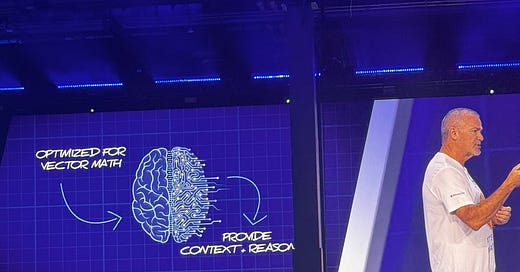#IntelAmbassador
I had the pleasure of being invited to DTW 2024 and it was a fascinating experience to say the least! The 3-day conference offered attendees a deep dive into the future of AI and its transformative potential. The conference was packed with valuable insights, cutting-edge product launches, and visionary strategies to harness AI for enterprises and consumers alike.
Here, I’ll share some key takeaways and my experiences from the event, focusing on the five core beliefs that Jeff Clarke, COO of Dell, presented for accelerating AI adoption, and the exciting advancements in AI integration into PC infrastructure.
Jeff Clarke’s Keynote
Five Core Beliefs to Accelerate AI Adoption
Jeff Clarke outlined five fundamental beliefs that are pivotal for organizations aiming to leverage AI effectively. These beliefs are designed to create a robust foundation for AI initiatives, ensuring they are scalable, efficient, and impactful.
Data is a Differentiator
Organizations are only as successful as the quality of data they possess. Clarke emphasized that the ability to collect, analyze, and act on data is what sets successful companies apart. Organizations must prioritize data management and analytics to derive actionable insights that drive innovation and competitive advantage.
Bring AI to Your Data
Traditional data processing often involves moving data to AI models, which can be inefficient and costly. The new paradigm shifts towards bringing AI to the data, meaning AI models and processing capabilities are integrated where the data resides. This approach minimizes latency, reduces costs, and enhances security by limiting data movement.
Right Size Your IT
It's crucial for businesses to align their IT infrastructure with their specific needs and growth trajectories. Clarke discussed the importance of scalable solutions that can adapt to varying workloads and demands. Right-sizing IT infrastructure ensures optimal performance and cost-efficiency, enabling organizations to invest in AI technologies without overextending their resources.
Open and Modular Architecture
Flexibility and interoperability are key to future-proofing IT investments. An open and modular architecture allows businesses to integrate diverse technologies and scale their systems as needed. This approach promotes innovation and ensures that organizations can quickly adapt to technological advancements and evolving business requirements.
Open Ecosystem
Collaboration and partnerships are essential in the AI landscape. An open ecosystem fosters innovation by allowing organizations to leverage the expertise, tools, and platforms of various stakeholders. Clarke highlighted the importance of building and participating in ecosystems that support shared growth and knowledge exchange, driving the collective advancement of AI capabilities.
The Evolution of Multimodal RAG Systems
The next significant highlight of the conference was the emphasis on Multimodal Retrieval-Augmented Generation (RAG) systems. These systems are pivotal for businesses looking to harness the full potential of their diverse data sources.
Text-Only RAG versus Multi-modal RAG (Source: Val Andrei Fajardo (LlamaIndex))
Here’s what a business might gain from multimodal models and RAG:
Ingest All Your Knowledge
Multimodal RAG systems can integrate various types of information, including presentations, photos, handwritten notes, and voice memos. This capability transforms these diverse data forms into a comprehensive knowledge base. For instance, a GenAI solution could leverage every sales presentation or a patient’s entire medical history, including medical imaging, to provide more accurate and comprehensive insights.
Increase AI Accuracy and Comprehension
By limiting input to defined knowledge bases, RAG eliminates noise from extraneous sources. Including images, audio, and video in these knowledge bases provides more context and nuance, enhancing AI accuracy and comprehension. Multi-hop reasoning in RAG systems enables near-human levels of association and understanding.
Launch Custom Multimodal GenAI Fast
RAG’s ability to augment pre-trained large language models (LLMs) means businesses can create accurate GenAI systems without extensive training cycles. This rapid deployment capability allows for the quick addition of new data and use cases, enabling businesses to build new knowledge bases efficiently.
Multimodal RAG Architecture
The architecture of a Multimodal RAG system was showcased using an intricate diagram, highlighting the integration of various components:
Enterprise Data: Ingests images and videos.
Embedding Model: Utilizes the BridgeTower model for embedding data.
Index/Vector Database: Stores indexed data for retrieval.
LVLM Inference: Employs the LLAVA model for inference, leveraging Intel’s 3rd Gen Xeon processors and Gaudi 2 AI accelerators.
Prompt Processing and Retrieval/Rank: Processes user queries and retrieves relevant data for accurate responses.
Multimodal LLM with RAG Integration - Trained on Intel® Gaudi® AI Accelerator | Intel
(Will add this video here)
This architecture underscores the seamless integration and processing capabilities of Multimodal RAG systems, enabling efficient and accurate AI-powered responses.
Gaudi 3 Performance
The performance of Intel’s Gaudi 3 processors was highlighted compared to H100 and H200 for training and inferencing tasks. Gaudi 3 demonstrated superior capabilities, offering faster processing times and enhanced efficiency. This makes it a powerful tool for enterprises implementing high-performance AI solutions boosting the competition with Nvidia!
In his presentation, Vasudev Lal showcased an array of developer resources for their Gaudi AI processors, emphasizing the tools available for optimizing machine learning models. The resources highlighted include the Intel Gaudi Developer Site, which provides performance data for various models, the Intel Gaudi GitHub repository with comprehensive model references, and the Intel Gaudi Optimum Library on Hugging Face Hub. These resources are designed to assist developers in leveraging Gaudi's capabilities to enhance AI model training and deployment, underscoring Intel's commitment to bringing AI everywhere.
Vasudev also shared how to execute large-scale distributed training jobs on Intel Gaudi processors using PyTorch Lightning. By simply configuring the HPUAccelerator and HPUParallelStrategy within the Trainer class, developers can easily leverage Gaudi's acceleration capabilities. The setup supports seamless scaling to 512 Gaudi processors, enabling efficient training of complex models, such as the convergence of Masked Language Modeling and Image-Text matching. This process involves handling over 20 million image-text pairs and highlights the integration with Kubernetes for distributed training, showcasing Intel's advancements in AI infrastructure and training efficiency.
Vasudev highlighted the impressive price-performance ratio of their Gaudi processors, which offer 2x the performance at half the cost compared to competitors. As one of only two merchant silicon submissions for GPT-3 in the MLPerf Training 3.1 results, Intel Gaudi demonstrates significant efficiency gains across various AI benchmarks, including GPT-3, Stable Diffusion, ResNet, and BERT. This data showcases Intel Gaudi's ability to deliver high performance while optimizing costs, making it a compelling choice for AI training and inference workloads.
AI Integration into PC Infrastructure: Microsoft Copilot
One of the most exciting announcements at the conference was the integration of AI at the core infrastructure levels of PCs, with Microsoft Copilot taking center stage. This integration is set to revolutionize how we interact with our PCs, making AI an indispensable part of daily workflows.
The Copilot Button
A standout feature is the introduction of the Copilot button on PCs. This dedicated button provides instant access to AI-powered assistance, streamlining tasks and enhancing productivity. Whether you're drafting emails, managing schedules, or conducting research, the Copilot button offers seamless support with a simple press.
Intel + Microsoft collaboration to bring AI integrated to PC
Copilot for Sales
For enterprise customers, Microsoft Copilot for Sales is a game-changer. It leverages AI to analyze customer data, predict sales trends, and provide actionable insights. Sales teams can use Copilot to prioritize leads, personalize outreach, and optimize sales strategies, ultimately driving higher conversion rates and revenue growth.
Image: Microsoft Copilot for Sales features
Copilot for Finance
Similarly, Copilot for Finance is designed to assist financial teams by automating routine tasks, providing real-time financial analysis, and offering strategic recommendations. This tool enhances decision-making, reduces manual workload, and ensures financial operations run smoothly and efficiently.
Microsoft Copilot for Finance use-case
Recall Feature on Windows Machines
Another notable feature is the Recall function, which allows users to navigate through their past activities and retrieve information effortlessly. his feature is particularly beneficial for professionals who frequently need to reference previous work, track changes over time, or recover lost data. By providing a detailed chronological view of past actions, the Recall function allows users to quickly locate specific documents, emails, and application activities, thereby saving valuable time and reducing frustration. The Recall feature is a testament to how AI can enhance user experience by making PCs more intuitive and responsive to our needs.
Image: Microsoft Recall feature in PCs
Latent Diffusion Demo: Real-Time Super Hero Avatar Creation
A captivating demonstration of latent diffusion technology was also a highlight of the conference. In this demo, three photos were taken in real time, and a latent diffusion model was fine-tuned to create a custom superhero avatar. The application took 3 pictures of me, then fine-tuned the latent diffusion model which took about 2-3 minutes, and generating the image using a custom prompt I provided took about 20 seconds, showcasing the impressive speed and efficiency of the technology.
Image generated by me using Latent Diffusion Model running on Gaudi2
Conclusion
Dell Technologies World 2024 highlighted the incredible strides in AI adoption and integration. The five core beliefs presented by Jeff Clarke provide a strategic roadmap for organizations looking to harness AI effectively. Meanwhile, the advancements in PC infrastructure, particularly through Microsoft Copilot, demonstrate the practical applications of AI in enhancing productivity and efficiency.
The exploration of Multimodal RAG systems and the impressive capabilities of Gaudi 3 processors underscore the rapid advancements in AI technologies, paving the way for more innovative and efficient solutions. As we move forward, embracing these principles and technologies will be crucial for businesses aiming to stay competitive and innovative in the rapidly evolving digital landscape. The future of AI is here, and it's reshaping the way we work, live, and interact with technology. I am so excited to share more about it!














Very insightful 👍